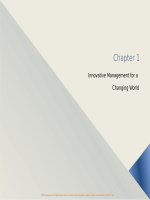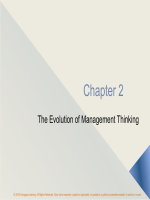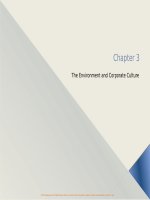Management 12e by w griffin ch13
Bạn đang xem bản rút gọn của tài liệu. Xem và tải ngay bản đầy đủ của tài liệu tại đây (1.83 MB, 40 trang )
TWELFTH EDITION
MANAGEMENT
Ricky W. Griffin
Part Four: The
Organizing Process
Chapter Thirteen: Managing
Human Resources in Organizations
© 2017 Cengage Learning. All rights reserved. May not be copied, scanned, or duplicated, in whole or in part, except for use as permitted
in a license distributed with a certain product or service or otherwise on a password-protected website for classroom use.
13 - 1
Learning Outcomes
1. Describe the environmental context of human
resource management, including its strategic
importance and its relationship with legal and
social factors.
2. Discuss how organizations attract human
resources, including human resource planning,
recruiting, and selecting.
3. Describe how organizations develop human
resources, including training and development,
performance appraisal, and performance
feedback.
© 2017 Cengage Learning. All rights reserved. May not be copied, scanned, or duplicated, in whole or in part, except for use as permitted
in a license distributed with a certain product or service or otherwise on a password-protected website for classroom use.
13 - 2
Learning Outcomes
4. Discuss how organizations maintain human
resources, including the determination of
compensation and benefits and career
planning.
5. Discuss labor relations, including how
employees form unions and the mechanics of
collective bargaining.
6. Describe the key issues associated with
managing knowledge workers and contingent
and temporary workers.
© 2017 Cengage Learning. All rights reserved. May not be copied, scanned, or duplicated, in whole or in part, except for use as permitted
in a license distributed with a certain product or service or otherwise on a password-protected website for classroom use.
13 - 3
Environmental Context of Human
Resource Management
Human resource management (HRM)
The set of organizational activities
directed at attracting, developing, and
maintaining an effective workforce.
HRM takes place within a complex and
ever-changing environmental context.
© 2017 Cengage Learning. All rights reserved. May not be copied, scanned, or duplicated, in whole or in part, except for use as permitted
in a license distributed with a certain product or service or otherwise on a password-protected website for classroom use.
13 - 4
Environmental Context of Human
Resource Management
Three vital components
of this context:
HRM
Environment
Strategic
importance
Legal
environment
Social
environment
© 2017 Cengage Learning. All rights reserved. May not be copied, scanned, or duplicated, in whole or in part, except for use as permitted
in a license distributed with a certain product or service or otherwise on a password-protected website for classroom use.
13 - 5
Strategic Importance of HRM
Human resources are critical for both
effectiveness and competitiveness.
Many firms develop strategic HR plans and
integrate them into other strategic plans.
Human capital
– reflects the organization’s investment in
attracting, retaining, and motivating an effective
workforce.
– A tangible indicator of the value of people.
© 2017 Cengage Learning. All rights reserved. May not be copied, scanned, or duplicated, in whole or in part, except for use as permitted
in a license distributed with a certain product or service or otherwise on a password-protected website for classroom use.
13 - 6
The Legal Environment of HRM
A number of laws regulate employee-employer
relations, especially in these areas:
Equal
employment
opportunity
Compensation
and benefits
Labor
relations
Occupational
safety and
health
© 2017 Cengage Learning. All rights reserved. May not be copied, scanned, or duplicated, in whole or in part, except for use as permitted
in a license distributed with a certain product or service or otherwise on a password-protected website for classroom use.
13 - 7
Table 13.1
The Legal Environment of HRM
© 2017 Cengage Learning. All rights reserved. May not be copied, scanned, or duplicated, in whole or in part, except for use as permitted
in a license distributed with a certain product or service or otherwise on a password-protected website for classroom use.
13 - 8
Equal Employment Opportunity
Title VII of the Civil Rights Act of 1964
– forbids discrimination on the basis of sex, race,
color, religion, or national origin in all areas of
the employment relationship.
– Applies to direct and indirect discrimination and
requires employment be based on qualifications.
Adverse impact
– exists when minority group members pass a
selection standard at a rate less than 80 percent
of the pass rate of majority group members.
© 2017 Cengage Learning. All rights reserved. May not be copied, scanned, or duplicated, in whole or in part, except for use as permitted
in a license distributed with a certain product or service or otherwise on a password-protected website for classroom use.
13 - 9
Equal Employment Opportunity
Equal Employment Opportunity
Commission (EEOC)
– is a federal agency charged with enforcing Title VII
and other antidiscrimination laws.
Age Discrimination in Employment Act
– outlaws discrimination against people older than 40
years; passed in 1967, amended in ‘78 and ‘86.
Both the Age Discrimination Act and Title VII
– require passive nondiscrimination or equal
opportunity.
© 2017 Cengage Learning. All rights reserved. May not be copied, scanned, or duplicated, in whole or in part, except for use as permitted
in a license distributed with a certain product or service or otherwise on a password-protected website for classroom use.
13 - 10
Equal Employment Opportunity
Affirmative action
– is intentionally seeking and hiring qualified or
qualifiable employees from racial, sexual, and
ethnic groups underrepresented in the organization.
– Employers holding government contracts require
affirmative action.
• Must have written action plans and employment goals.
• Require affirmative hiring for Vietnam veterans due to the
Vietnam Era Veterans Readjustment Assistance Act.
• The Pregnancy Discrimination Acts forbids discrimination
against women who are pregnant.
© 2017 Cengage Learning. All rights reserved. May not be copied, scanned, or duplicated, in whole or in part, except for use as permitted
in a license distributed with a certain product or service or otherwise on a password-protected website for classroom use.
13 - 11
Equal Employment Opportunity
Americans with Disabilities Act (ADA)
– prohibits discrimination against people with
disabilities.
– Passed in 1990, requires employers make
reasonable accommodations for employees.
Civil Rights Act of 1991
– amends the original Civil Rights Act, making it
easier to bring discrimination lawsuits while
also limiting punitive damages.
© 2017 Cengage Learning. All rights reserved. May not be copied, scanned, or duplicated, in whole or in part, except for use as permitted
in a license distributed with a certain product or service or otherwise on a password-protected website for classroom use.
13 - 12
Table 13.1
The Legal Environment of HRM
© 2017 Cengage Learning. All rights reserved. May not be copied, scanned, or duplicated, in whole or in part, except for use as permitted
in a license distributed with a certain product or service or otherwise on a password-protected website for classroom use.
13 - 13
Compensation and Benefits
Fair Labor Standards Act
– sets a minimum wage and requires overtime
pay for work in excess of 40 hours per week;
passed in 1938 and amended frequently.
– Salaried professional, executive, and
administrative employees are exempt.
Equal Pay Act of 1963
– requires that men and women be paid the
same amount for doing the same job.
© 2017 Cengage Learning. All rights reserved. May not be copied, scanned, or duplicated, in whole or in part, except for use as permitted
in a license distributed with a certain product or service or otherwise on a password-protected website for classroom use.
13 - 14
Compensation and Benefits
Employee Retirement Income Security
Act of 1974 (ERISA)
– regulates how organizations manage their
pension funds.
Family and Medical Leave Act of 1993
– requires employers provide up to 12 weeks of
unpaid leave for family and medical
emergencies.
© 2017 Cengage Learning. All rights reserved. May not be copied, scanned, or duplicated, in whole or in part, except for use as permitted
in a license distributed with a certain product or service or otherwise on a password-protected website for classroom use.
13 - 15
Table 13.1
The Legal Environment of HRM
© 2017 Cengage Learning. All rights reserved. May not be copied, scanned, or duplicated, in whole or in part, except for use as permitted
in a license distributed with a certain product or service or otherwise on a password-protected website for classroom use.
13 - 16
Labor Relations
National Labor Relations Act
– passed in 1935 to set up procedures for
employees to vote on whether to have a union;
also known as the Wagner Act.
National Labor Relations Board (NLRB)
– was established by the Wagner Act to enforce its
provisions.
Labor-Management Relations Act
– was passed in 1947 to limit union power; also
known as the Taft-Hartley Act.
© 2017 Cengage Learning. All rights reserved. May not be copied, scanned, or duplicated, in whole or in part, except for use as permitted
in a license distributed with a certain product or service or otherwise on a password-protected website for classroom use.
13 - 17
Table 13.1
The Legal Environment of HRM
OSHA requires that employers
(1) provide a place of employment that is free from
hazards that may cause death or serious physical
harm and
(2) obey the safety and health standards established
by the Department of Labor.
© 2017 Cengage Learning. All rights reserved. May not be copied, scanned, or duplicated, in whole or in part, except for use as permitted
in a license distributed with a certain product or service or otherwise on a password-protected website for classroom use.
13 - 18
Emerging Legal Issues
Sexual harassment
– Forbidden under Title VII, more victims confront the
problem in court.
Alcohol and drug abuse
– Court rulings define alcoholics and drug addicts as
disabled and protected under the same laws.
AIDS victims are covered under disability laws
Employee privacy
– Can you refuse to hire due to social media postings?
© 2017 Cengage Learning. All rights reserved. May not be copied, scanned, or duplicated, in whole or in part, except for use as permitted
in a license distributed with a certain product or service or otherwise on a password-protected website for classroom use.
13 - 19
Social Change and HRM
Many organizations are using more and
more temporary workers.
Dual-career families are much more
common today.
Employment-at-will
– is a traditional view of the workplace that says
organizations can fire their employees for
whatever reason they want; recent court
judgments are limiting employment-at-will.
© 2017 Cengage Learning. All rights reserved. May not be copied, scanned, or duplicated, in whole or in part, except for use as permitted
in a license distributed with a certain product or service or otherwise on a password-protected website for classroom use.
13 - 20
Human Resource Planning
Job analysis
– is a systemized procedure for collecting and
recording information about jobs within an
organization.
– There are two parts of a job analysis:
• A job description lists the duties of a job, working
conditions, and tools, materials, and equipment
used.
• A job specification describes the skills, abilities,
and credentials required to perform the job.
© 2017 Cengage Learning. All rights reserved. May not be copied, scanned, or duplicated, in whole or in part, except for use as permitted
in a license distributed with a certain product or service or otherwise on a password-protected website for classroom use.
13 - 21
Figure 13.1
Human
Resource
Planning
© 2017 Cengage Learning. All rights reserved. May not be copied, scanned, or duplicated, in whole or in part, except for use as permitted
in a license distributed with a certain product or service or otherwise on a password-protected website for classroom use.
13 - 22
Human Resource Planning
Forecasting labor supply involves two tasks:
– Forecasting the internal and external supply.
– Replacement charts can be used to plan for
management positions.
– Employee information systems or skills
inventory contains information on each
employee’s education, skills, experience, and
career aspirations.
– Forecasting external supply is a different problem.
• Planners must rely on information from outside sources.
© 2017 Cengage Learning. All rights reserved. May not be copied, scanned, or duplicated, in whole or in part, except for use as permitted
in a license distributed with a certain product or service or otherwise on a password-protected website for classroom use.
13 - 23
Human Resource Planning
Matching human resources supply and
demand requires managers plan and deal
with predicted shortfalls or overstaffing.
– If hiring, managers use recruitment and
temporary works to gain flexibility.
– If overstaffed, managers may transfer
workers, not replace those who quit,
encourage early retirement, and layoff extra
employees.
© 2017 Cengage Learning. All rights reserved. May not be copied, scanned, or duplicated, in whole or in part, except for use as permitted
in a license distributed with a certain product or service or otherwise on a password-protected website for classroom use.
13 - 24
Recruiting Employees
Recruiting
– is the process of attracting qualified individuals to
apply for open jobs.
– Internal recruiting
• considers current employees as applicants for higher-level
jobs.
– External recruiting
• attracts persons outside the organization to apply for jobs.
– Realistic job previews
• provide applicants with a real picture of what it is like to
perform the job.
© 2017 Cengage Learning. All rights reserved. May not be copied, scanned, or duplicated, in whole or in part, except for use as permitted
in a license distributed with a certain product or service or otherwise on a password-protected website for classroom use.
13 - 25









